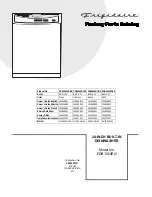
Frequently Asked Questions
79
Problem
Possible cause and solution
Plastic parts are discol-
ored.
Natural dyes, e.g., from carrots, tomatoes, or
ketchup may be the cause. The amount of detergent
used or its bleaching effect was not sufficient to deal
with natural dyes.
Use more detergent (see “Detergent”).
Parts that are already discolored will not revert to
their original color.
White residue is visible
on the dishware. Cloud-
ing has occurred on
glassware and utensils.
The film can be wiped
off.
The rinse-aid dosage is set too low.
Increase the dosage (see “Rinse aid” under “Set-
tings”).
The salt reservoir is empty.
Fill the salt reservoir (see “Reactivation salt” under
“Before using for the first time”).
The salt-reservoir cap has not been screwed on cor-
rectly.
Replace it, making sure that it screws back on cor-
rectly.
Unsuitable combination detergents were used.
Switch to another detergent. If using detergent
tabs or powder detergent, do not choose combi-
nation products and ensure you refill the reactiva-
tion salt and rinse aid.
The water softener is programmed to too low a water
hardness level.
Program the water softener to a higher water hard-
ness level (see “Water hardness” under “Set-
tings”).
Too much detergent was dispensed.
Reduce the dispensing quantity during automatic
dispensing (if available) (see “Settings – AutoDos”).
Activate the “Second interim rinse” function (see
“Settings – Second interim rinse”).
Not enough combination detergent was dispensed.
The water softener performance is not sufficient.
Increase the dispensing quantity during automatic
dispensing (if available) (see “Settings – AutoDos”).
Add more reactivation salt.
Содержание G 7151
Страница 2: ......
Страница 92: ......
Страница 93: ......
Страница 94: ......
Страница 96: ...M Nr 11 838 210 01 en US G 7151 G 7156 ...
















































